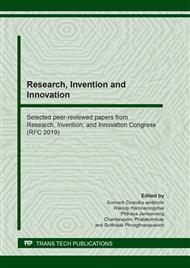p.92
p.99
p.106
p.112
p.119
p.128
p.135
p.143
p.152
Development of the Fuel Briquette Compression Machine for Palm Residue
Abstract:
The objectives of this research is developed the fuel briquette compression machine and studied the properties of fuel briquette of palm residue from a community palm oil production process in Thailand. The palm residue from a community palm oil production process had a palm meat and a mixed fiber. It was a material for testing. The fuel briquette has the standard shape. Because palm meat and fiber are tough to make fuel therefore the design and building of fuel briquette compression machine were hydraulic system. The fuel briquette compression machine was developed to be easy to use and increase production rate of fuel briquette. The fuel briquette compression machine from palm residue was divided of 3 Hp motor, hydraulic pump, cylinder, and forming mold set. The ratios of ingredients for testing of fuel briquette extrusion (palm residue : water : cassava starch) were 1:1:1, 2:1:1, 3:1.5:1, and 4:1.5:1 kg. The experimental pressures were 108, 147 and 196 N/cm2. From the result, it was found that the production rate of fuel briquette was higher than S. Wannapakhe (2018)’s. The properties of fuel briquette were passed the standard except the property of density value that was near the standard. The highest of production rate by using pressure, was 20 kg/cm2 at the ratio of ingredients of 4:1.5:1 kg.
Info:
Periodical:
Pages:
119-127
Citation:
Online since:
August 2020
Authors:
Keywords:
Price:
Сopyright:
© 2020 Trans Tech Publications Ltd. All Rights Reserved
Share:
Citation:


